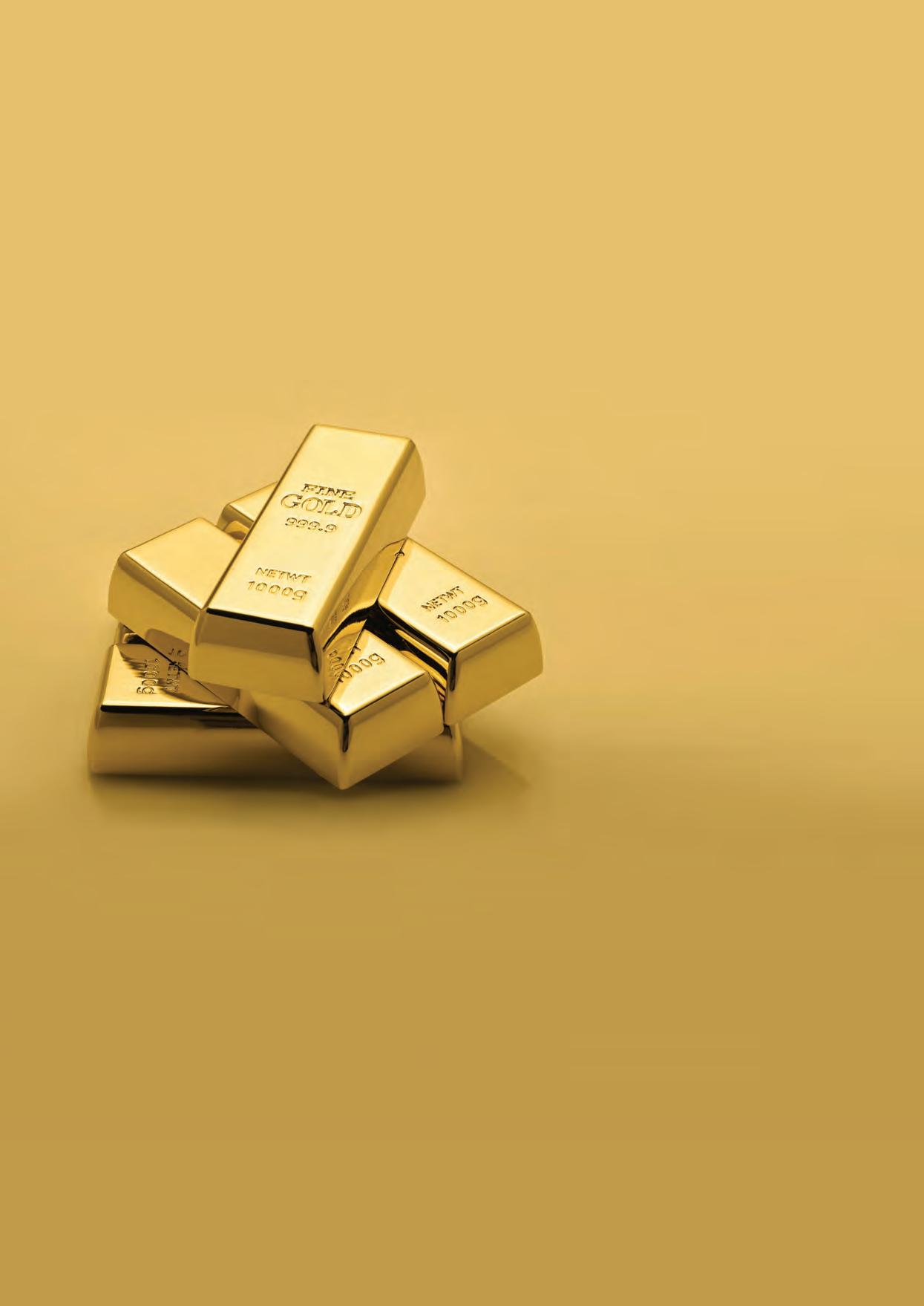
6 minute read
The gold outlook for 2022
After 2021’s ups and downs, what can we expect of gold in 2022? Andrew Naylor, regional CEO APAC (ex China) of the World Gold Council, details the year ahead and the various factors that could impact the commodity’s performance.
Gold is likely to face similar dynamics in 2022 to those of 2021.
2021 was a mixed year for gold – although consumer demand started to recover, weaker investment demand saw the price soften from the record highs of 2020.
Gold finished the year approximately 4 per cent lower, closing at $US1806 ($2515) per ounce. The gold price rallied into the yearend on the heels of the rapidly spreading Omicron variant, likely prompting flightto-quality flows, but it was not enough to offset first-half weakness.
SOURCES OF DEMAND
To understand the outlook for gold, it’s important to appreciate the sources of demand. Gold is a unique asset in that its demand profile is unlike any other.
Economic expansion tends to support consumer demand (bars, coins and gold jewellery). It also supports industrial demand, which on average accounts for approximately 7 per cent of annual demand.
Conversely, economic uncertainty is a big driver of investment demand. Other factors, including the interest rate environment and tactical positioning, also influence investment interest in gold.
But it’s this unique demand profile – it has both pro- and counter-cyclical demand – and its use as an industrial asset as well as a financial asset, that makes gold so interesting.
In short, it can perform differently to other assets. This is reflected in its lack of strong correlation to many other assets, particularly in downturns. And there results one of its key uses in a portfolio – as a diversifier.
INFLATION
A major theme on the economic horizon is inflation. In the final quarter of last year global inflation continued to rise, especially in the United States where it rose to 7 per cent in December. This is the highest since 1982.
Germany and the United Kingdom are also impacted, with both recently posting the highest inflation figures in 20 years. Although the Australian inflation story hasn’t been as pronounced, it’s still a concern and is one of the factors driving interest in gold.
Gold has long been considered a hedge against inflation and the data confirms this. The average annual return of 11 per cent in US dollars over the past 50 years has outpaced the Australian and world consumer price indices (CPI).
World Gold Council research demonstrates that gold also protects investors against high and extreme inflation. In years when inflation was higher than 3 per cent, gold’s price increased 20 per cent per year on average. Over the long term, therefore, gold has not just preserved capital but helped it grow.
OUTLOOK FOR GOLD
Gold is likely to face similar dynamics in 2022 to those of 2021. Competing forces will both support and curtail its performance.
Consumer demand will likely be supported by the continuing economic recovery, particularly in the major goldconsuming markets of Asia. Near term, gold’s performance will likely be impacted by real rates in response to the speed at which global central banks tighten monetary policy. Their effectiveness at controlling inflation will also have an impact.
As we start 2022, the US Federal Reserve is signalling a more hawkish stance. Its projections suggest the Fed will hike interest rates approximately 3 times over the course of the year.
This is quicker than expected, but World Gold Council analysis of previous cycles of monetary tightening shows that the Fed has tended not to tighten as aggressively as members of the committee previously indicated.
Our research also suggests that gold typically underperforms in the run up to a Federal Reserve tightening cycle only to rebound in the period following the first rate hike.
A second point of consideration is that gold is a global market. Approximately 74 per cent of annual demand for physical gold comes from emerging markets.
Not all central banks will be as hawkish as the Fed. The European Central Bank (ECB), for example, has suggested that it is “very unlikely” interest rates will rise in 2022. The Bank of England increased rates at the end of last year, but it seemed to indicate only modest future hikes.
In India – the world’s second largest gold market – the Reserve Bank of India (RBI) has suggested it will maintain an accommodative policy, and the People’s Bank of China (PBOC) cut one of its policy rates in December. The global picture – at least as far as interest rates are concerned – is certainly mixed.
Although increase in interest rates can create headwinds for gold, our research suggests that historically their effect may be limited. Coupled with this is the inflation picture – elevated inflation and market pullbacks will likely sustain demand for gold as a hedge, particularly from institutional investors.
Gold will face both head- and tail-winds in 2022. Potential headwinds include higher nominal interest rates and a stronger US dollar. Supporting factors include high and persistent inflation, continued market volatility, and robust demand from other sectors including consumer demand, industrial demand and central banks.
To help navigate the complex dynamics that impact gold’s performance, the World Gold Council has developed a valuation tool called Qaurum. This can be used to analyse how some of these drivers can impact gold’s performance.
THE NEW ECONOMY
Two other trends are likely to have an impact. The increasing focus on sustainability is guiding investment decisions. Reports suggest that over 55 per cent of assets in Australia are now managed with a sustainability lens.
The gold industry has led the way explaining its environmental, social and governance (ESG) credentials. The Responsible Gold Mining Principles is one example. Launched in 2019, the Responsible Gold Mining Principles is a framework that sets out clear expectations for consumers, investors, and the industry as to what constitutes responsible mining.
The industry has also taken a lead in decarbonisation, with work undertaken to quantify the sector’s greenhouse gas emissions, and major steps taken to reduce its carbon footprint.
Finally, the digitisation of finance will also have an impact. Gold is sometimes compared to cryptocurrencies. For the reasons explained above, they are fundamentally different asset classes and whilst interest in crypto might grow, it should not come at the expense of gold demand.
Gold has a unique role to play – as a physical asset with limited supply and diverse sources of demand, it behaves differently to other assets and is often considered an effective risk mitigator. It is also a highly liquid asset (over $145 billion is traded every day) and it does not exhibit strong correlations with other major asset classes, making it a potential portfolio diversifier. The same cannot be said of crypto-assets. Andrew Naylor joined the World Gold Council in 2016 and since 2020 has led our regional office in Singapore. Originally part of the central banks and public policy team, Andrew was responsible for our Islamic finance initiative, culminating in the launch of the AAOIFI Shari’ah Standard on Gold.
Andrew started his career at international consultancy firm Cicero Group advising financial institutions on foreign investment and trade policy in Asia, and the global regulatory reform agenda. In this role, he provided economic and political commentary for global broadcasters including the BBC, Bloomberg, CNBC and China Central TV.












